
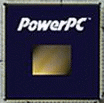
It has been almost ten years since the Amiga began its
sloth-like march to RISC processing. The path has been
unpredictable and at many points it appeared that it would never
reach its destination. The torch has been repeatedly dropped, only
to be picked up by another developer. Now, in the third millennia,
the Amiga is finally showing signs of moving away from the Motorola
68k. This is the story of the struggle to bring PowerPC to the
Amiga users.
Pre-PowerPC: the Commodore Years
The Amigas' relationship with the Risc processor dates back to
1992. Against the odds, Commodore had released the A1200 &
A4000 machines. These had proved to be a disappointment to
Commodore engineering, who had been forced to cancel several
projects that offered significant improvements over the
top-of-the-line A4000 (such as the A3000+). Despite the budget cuts
placed upon them, the Commodore engineering team were developing
several solutions that would allow the Amiga brand to be associated
with faster, better RISC processors. At the time, the PowerPC
alliance was not even a gleam in IBM's eye. Instead, Commodore
licensed Hewlett Packard's PA-RISC processor. This would form the
basis of a new chipset, code named Hombre, that would provide a significant
performance boost to the flagging Amiga market. Dave Haynie has
repeatedly stated that Hombre was only intended for the console
market, allowing Commodore to develop a Playstation-like unit (the HP deal did not allow
the use of the RISC chip in desktop computers).
However, the project was hit by repeated delays over the next two
years. Development funding was cut several times, forcing a number
of ideas, prototypes, and projects to be abandoned. The CD32 became
Commodore's last, best hope for profits. However, it failed in most
countries (apart from the UK where it dominated the early CD
market) and Commodore entered into liquidation.
In hindsight Dave Haynie, head of
engineering at Commodore, assumed that a PowerPC-based 'Amiga'
computer would have been developed at some point (had finances
allowed). Whilst the decision may or may not have come to pass it
would have been irrelevant for the Amiga market; could a PPC
machine that ran Windows NT (or some other OS) still be called an
Amiga. Aesthetically yes but, as the current definition of an Amiga
is one that runs the Amiga operating system, it would not.
Good-bye PA-RISC. Hello PowerPC!
The Amiga's development was halted for over a year during the slow,
painful process of liquidating the parent company. After almost a
year, Escom purchased the remains of Commodore, and the Amiga along
with it. In general, the Escom period was a dark time for all Amiga
owners. The only light was the announcement by Amiga Technologies
that they had formed a strategic alliance with Phase 5 to migrate
the market towards the PowerPC. Apple had already had considerable
success in this area, moving Macintosh users' to their PowerMac
platform, Amiga Technologies hoped to emulate this success.
Both Amiga Technologies and Phase 5 recognized that the transition
would be a difficult one. On average, Amiga users were concentrated
in the low-end of the market, while the Macintosh was at the
high-end of the scale. It would be difficult to persuade many Amiga
owners to buy a new machine. A three-stage strategy was
introduced.
| Stage 1 |
Phase 5 develop and manufacture PPC accelerators for existing
Amigas (A1200, A2000, A4000, and the soon to be launched,
Walker). |
| Stage 2 |
Amiga Technologies would develop a PPC AmigaOS Port |
| Stage 3 |
An official PowerAmiga machine
would be launched in 1997 |
The plan was optimistic, reliant upon a great deal of funding
from Escom and Phase 5 to succeed. In reality Escom were having
financial difficulties and the relationship between Phase 5 and
Amiga Technologies was not as cozy as it first appeared. This was
the least of their worries when Escom went into liquidation during
July 1996 taking Amiga Technologies with them. Phase 5 were left to
carry the PowerPC torch alone.
The Amiga Orphan
The Amiga had once again found itself in a state of flux. In the
absence of an official parent company, several developers were
laying claim to the Amiga market: VISCorp and Quikpak were fighting
over the remains of Amiga Technologies, while Phase 5 and PIOS were
fighting an ideological war to gain mind share in the Amiga market.
This provided a confusing array of options for the Amiga
market.
| VISCorp |
Quikpak |
Phase 5 |
PIOS (later known as Met@box) |
| Sell the Amiga as a set-top box |
Port the AmigaOS to the Alpha
CPU |
Migrate the Amiga market to the A/Box |
Migrate the Amiga market to the TransAM |
The PPC alternatives were interesting by their diverse approach:
PIOS, founded by the former Amiga Technologies, had created
their own CHRP based PowerPC based upon standard components. A
combination of existing operating systems would be bundled with the
machine - BeOS, LinuxPPC, MacOS and pOS. In contrast, Phase 5 were
developing a custom-designed PPC system, utilizing a modern custom
chipset. A custom OS, dubbed PhaseOS, would blend the distinction
between AmigaOS 3.1 & Unix. The A\Box
was promoted as a modern successor to the Amiga.
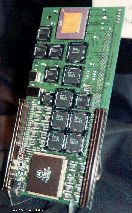 Another year passed (1997), allowing Phase 5 to
continue their work alone. The company had made significant
progress in the design of the PPC accelerators and were undergoing
final testing. Meanwhile, the Amiga had moved onto its fourth owner
- Gateway 2000. At first the company was only interested in the
Amiga patents, but soon realized that they had bought a previously
untouched market-share. The times were changing and the Amiga was
ready for its comeback tour. Another year passed (1997), allowing Phase 5 to
continue their work alone. The company had made significant
progress in the design of the PPC accelerators and were undergoing
final testing. Meanwhile, the Amiga had moved onto its fourth owner
- Gateway 2000. At first the company was only interested in the
Amiga patents, but soon realized that they had bought a previously
untouched market-share. The times were changing and the Amiga was
ready for its comeback tour.
At last! PowerPC on the Amiga!
During October 1997, Phase 5 finally launched their range of
PowerPC accelerators. The PowerUP boards were divided into low and
high-end markets. The Cyberstorm PPC was aimed at the high-end
markets (A2000 & A4000). The card was attached via the CPU
slot. The low-end (A1200) was served by the Blizzard PPC, that was
slotted into the A1200 trapdoor. In addition to the launch of PPC
boards, Phase 5 did not neglect their graphics card market. The
BlizzardVision and CyberVisionPPC offered a significant performance
boost over existing solutions, using the PerMedia 2 chipset, rather
than the ancient S3 found in previous CyberVision cards.
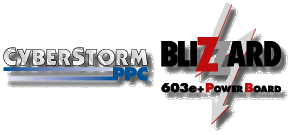
The PowerUP boards interact with the Amiga operating system in an
interesting fashion. They are essentially dual-processor boards,
incorporating the PPC and a 68k processor (68LC040, 68040 or
68060). The AmigaOS still requires a 68k processor, while the PPC
acts as an extremely fast coprocessor that carries out specific
instructions. Unfortunately, this causes significant slowdown when
the OS task switches between the 68k and PPC. Rather than being the
Amigas' saviour, the PPC boards attracted even more criticism by
Windows and Mac users. The hope that PowerPC would bring the price
of a fast Amiga system down had been dashed.
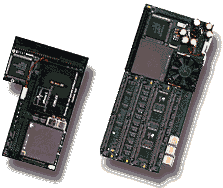
In an attempt to solve many of the problems experienced and
increase the PPC's performance, Haage & Partner developed a
competing API called WarpOS. Phase 5 reacted strongly to this
competition, writing a stream of criticism, open letters, and
threats to H&P. The ELF format implemented by Phase 5 was aimed
at steering the Amiga PPC market towards their own A/Box solution. In contrast, the WarpOS approach
was more system friendly, implementing the Amiga HUNK format and
using instructions that were made illegal by Phase 5. The
child-like bickering spread across the public forums, dividing the
tiny PPC market into two smaller cults. A line had been drawn in
the sand and the two gun slingers were prepared to take the entire
town with them. A sheriff was needed to protect the peace.
Gateway, Amiga, MCC, and all that malarkey
The PowerPC was a disappointment to even the most ardent Amiga
fanatic, demonstrating problems that could only be repaired by a
clean rewrite of the OS. To strengthen the market, Amiga
International announced that the
68k&PPC approach was officially supported. This was a temporary
measure that, it was hoped, would buy the company some time to
develop a long-term PowerPC strategy. This announcement was
followed by a second, indicating an AmigaOS license had been
granted to Phase 5, for its use in their pre\box system. The machine, retailing between
£1500 - 4000UKP, would be marketed at the high-end of the
market. The specifications were most interesting, indicating that
the pre\box would be shipped with four PPC processors as standard
(possibly more). The announcement gained widespread attention from
the Macintosh market, who looked at their Amiga owning cousin with
new-found envy. In the lower end of the market, Index Information's
BoXeR ATX motherboard was altered to allow connection of a PowerUP
accelerator.
For the first time in years, the Amiga market became a predictable
entity - Amiga magazines cheerfully announced that a PPC AmigaOS
would soon be released, and a range of Mac/PC titles were in
negotiation for porting to PowerPC. The PowerPC future looked
bright if slightly boring, unknown to everyone but Amiga
Incorporated, the future was to be thrown into confusion again.
At the World of Amiga show (1998) in London, all bets on the
Amigas' future were off. Amiga Inc. announced that the future of
the Amiga did not lie with PowerPC, but an as-yet unannounced CPU
that was due for release during the next year. In one day the PPC
market had changed, looking bleaker than ever - contracts were
canceled and panic spread to all corners of the Amiga world. It was
feared that, without the official support of Amiga Inc., PowerPC
sales would flop and Phase 5 would abandon the market. In the
aftermath of the announcement, Haage & Partner organized an
emergency meeting with their old enemies, Phase 5. While Phase 5's
business practices had been compared to Microsofts' on occasions,
they were forced to change their attitude to outside developers, or
become irrelevant in the new Amiga market. A fragile partnership
was formed between the two warring developers: Haage & Partner
would develop software drivers and Phase 5 would continue to
produce PPC hardware. Neither business were happy about the
arrangement, but it became a necessary move in the fragile market
conditions. Phase 5 also submitted an alternative OS5 development
proposal that suggested the Amiga market could be better supported
by creating a PPC developers board, as well as the x86 model that Amiga Inc. had announced. Amiga
Inc. accepted the proposal and gave permission for a PPC 'AmigaOS
v5' port.. At the time of announcement Amiga Inc. were not sure
where they would find a new operating system. A strategic
partnership with Be had been abandoned a few days previous and it
would be a few months until QNX was proposed as an alternative
solution. The deal with Phase 5 to port the new OS to PPC was an
empty gesture that may have been impossible later (based upon the
OS partner choice)
The disaster had been averted, but the Amiga market was still
shaken by Amiga Inc's turnaround in the PowerPC decision. The Amiga
PPC market had changed from the processor of the future, to an
interesting sideline for existing Amigas. The market would continue
to develop, but its expansion was slower than if the processor had
Amiga's official blessing.
PowerPC: The Second Generation
The PowerPC market had changed considerably since 1996 - Apple had
moved to faster PPC processors and launched a sub-£1000
machine called the iMac, CHRP was dead, and
Motorola and IBM were having significant disagreements over their
future direction. In the turbulent Amiga market, the PPC boards had
been accepted as the only existing method of upgrading many user's
machines. A range of interesting titles were released or in
development - PPC Doom, Quake, WipeOut 2097, Heretic 2 are
particularly interesting for PPC gamers. In the midst of these
events, many developers who had fought in the first Amiga PPC war
were preparing a second attack.
| Phase 5 |
Met@Box (formerly PIOS) |
Escena |
Announced G3 & G4 boards, later canceled the G3.
Late 1999 they announced a deal with QSSL and the AMIRAGE K2 |
Announced the AmiJoe G3 card |
Demonstrated G3 PPC Zorro III board at the Computer '98
show. |
Though smaller than it was a year previous, early 1999 was a
cheerful time for the Amiga market. The Amigas' future was secure,
thanks to the QNX operating system, and Amiga Inc. had announced
that the first OS upgrade in four years, AmigaOS 3.5, would support existing PPC boards.
There were also indications that they had given Haage & Partner
permission to develop the OS for PPC.
Three other businesses were expressing interest in developing a
PowerPC expansion for the Amiga. The first announcement came from
Escena, followed by Phase 5 & Met@Box.
Unlike earlier efforts, these boards would utilize 68k emulation,
allowing the production of cheaper PPC-pure systems that did not
require the 68k CPU or time-consuming task switching.
Unfortunately, the announcements and prototypes never resulted in a
tactile product. The Phase 5 G3 were canceled to allow them to
better market the G4 board and the
Escena board was delayed. After two years of silence, Eyetech
indicated that the updated card would be used in the AmigaOne.
The story of Phase 5 at the time is particularly interesting.
They had been irritated by their partnership with Haage &
Partner for years and were desperate to find an alternative
solution that would allow the business to expand. They were also
beginning to recognize that their software support did not meet the
high quality of their hardware. They needed a high profile ally
that would allow them to expand beyond the limited Amiga/Mac
markets. In the aftermath of Amiga's Linux decision, Phase 5 found
the ally that they needed. In a questionable move, Amiga Inc. had
dropped the OS partnership with QNX, in favour of Linux. QSSL were
understandably annoyed at the expense and promotion they had wasted
in the Amiga market. They still had plans to expand into the
desktop market, but needed an initial hardware partner that could
deliver. Phase 5 and QSSL were the perfect couple that had both
been jilted by Amiga at different stages.
In a series of announcements, the two companies indicated their
intention to develop an Amiga-competitor in the desktop market. The
Neutrino OS would be ported to the Phase
5 PowerUP & G4 cards and a QNX-based PPC system, called
AMIRAGE K2, would be launched. Once
again, Phase 5 were attempting to migrate Amiga users' to another
operating system. Existing Amigas could use legacy Amiga
applications and their QNX alternative. To continue using QNX, they
would upgrade to the custom-built AMIRAGE
K2. It was a cunning, yet obvious move that would shift the
Amiga user base onto the QNX OS. Sympathy for QNX gave them the
upper hand, potentially damaging Amiga's image. Although Amiga had
promised to port the Amiga OE to PowerPC platforms, an alternative
may have moved the tide against them if it was released first.
Unfortunately the AMIRAGE was never released when, on January 26th
2000, Phase 5 applied for insolvency with their local court. In the
absence of an Amiga partner, QSSL canceled their plans to port
Neutrino to the Amiga hardware. The company (QSSL) had gained
considerable expertise from the Amiga market, particularly from the
newly formed Phoenix Consortium, and
were preparing to launch their operating system for the x86. Like
BeOS before it, QNX would be available as a
free download, allowing consumers to try it for themselves.
2000: New World Order
After Gateway canceled the Amiga MCC, Amino had entered into negotiations to
purchase the Amiga (minus the patents). Their announcement, at the
end of December 1999, bought considerable joy to the Amiga market.
Once again the Amiga had been saved! However, this was bad news for
Haage & Partner, who were informed that their AmigaOS4 PPC
contract was canceled. An official PPC AmigaOS port was no longer
possible, but this did not stop an unofficial version being
developed. In April 2000 an announcement was made that immediately
made the Amiga world hopeful. It read:
Are you frustrated that there have been no major steps
forward towards an updated Amiga Operating System since 1993 ?
The people which formed the face of the Amiga desktop since 1993
...will bring you now what you've always wished for....
AmigaOS running on PPC in 2000
Unlike previous promises this was followed by results - MorphOS, an Amiga-compatible operating system,
was released as an open beta. Several developers had promised
versions of their popular applications for the new operating system
and existing 68k programs could be executed through emulation.
MorphOS symbolized the product that everyone had wished for, yet no
one had been able to deliver.
These announcements were followed by the launch of a new busboard
solution by Elbox. Unlike previous boards (Zorro 2/3/4, ISA), the
Mediator offered a modern interface, utilizing PCI slots.
CyberVision & Picasso drivers were also being written
to allow the use of S3, Voodoo 3 graphic cards, Ethernet cards, and
more. This was followed by announcements that they would release
the SharkPPC, a G3 card that could be used with the Mediator.
These announcements sparked a wave of criticism from competing
companies, that accused Elbox of using an unethical methods to
develop the Picasso96 drivers without permission from the Picasso96 API authors. The argument quickly
broke down to the childish attacks seen in
the P5 Vs. H&P war, 3 years previous.
The Amiga market is divided into three hardware possibilities and
three operating systems.
Hardware mind share is equally divided between the
following:
| Elbox |
Eyetech |
Met@Box |
| Launch Mediator PCI busboard and
announce SharkPPC |
Developing the official AmigaONE upgrade.
Launch the Predator PCI/AGP busboard and G3 card |
No news on the AmiJoe front |
While the 'Classic' market had been promised a new lease of
life, Amiga Inc. were issuing a series of announcements regarding
the next generation Amigas. They promised compatibility across
platforms, new hardware within a year, and a clean break from the
past. Eyetech became a Amiga DE hardware partner, announcing
the Predator PCI busboard and G3 card, a competitor to the Elbox
model. Though Amiga Inc. are having little to do with the argument,
it is clear that they are supportive the Eyetech solution due to
their long years of service to the market.
The announcement at the Amiga 2001 show in St. Louis that Amiga
Inc. were resurrecting the AmigaOS came as a shock to many people.
The promise that OS4.0 would be
PPC-native and provide 68k emulation was too good to be true. After
seven years, the AmigaOS is following the Macintosh onto the
PowerPC platform, acting as a desktop/server OS. However, the
concern that the PPC AmigaOS market will become another niche
product has become a major stumbling block. Who would buy a PPC
server? How will Amiga Inc. attract new users to the AmigaOS. At
present, the only obvious method would be to promote the AmigaOS as
the perfect platform for Amiga DE. However, it is still a high risk
option - the Amiga DE remains an obscure, unknown to the rest of
the computing world.
Operating System mind share:
| PPC-native Amiga OS 4.x |
Amiga DE (x86, PPC, etc.) |
MorphOS |
QNX x86 |
| The official next generation Amiga product. Available for
AmigaOne and Classic Amiga PPC boards. |
Multi-platform solution. Amiga users' who can't afford a PPC
machine will go for this option. Has gained significant support
from the PDA market. |
AmigaOS-compatible PPC operating system that runs on Classic
Amiga PPC hardware. Will be available for the bPlan Pegasos motherboard. |
QSSL & Phoenix continue to gain support from Amiga users'.
Not available for Amiga hardware. |
The market is in a familiar position that has been seen many
times before:
- The 'Classic Amiga' is awaiting the launch of new PPC boards,
PPC operating system, and PCI busboards that will liberate their
old and outdated machines.
- Just over the horizon AmigaOS 4.0 promises new PPC hardware and
software. Amiga DE will take the Amiga name beyond the confines of
the PPC to the PDA and x86 market.
It would appear that the wait is almost over. It has taken many
years, but the Amiga has finally broken free of the slow, propriety
solutions that characterized the Commodore era, and has moved onto
cheap industry standard parts that offer significant advantages
over the old. The only question that remains unanswered is, which
market will the Amiga user support - the unofficial MorphOS or the official AmigaOS4.x and Amiga Anywhere?
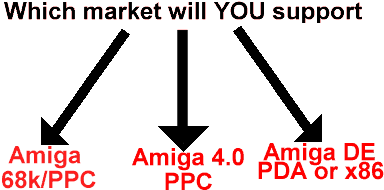
External Links
DCE
Escena
MorphOS
BACK
Last Update: 13/6/2002
|













